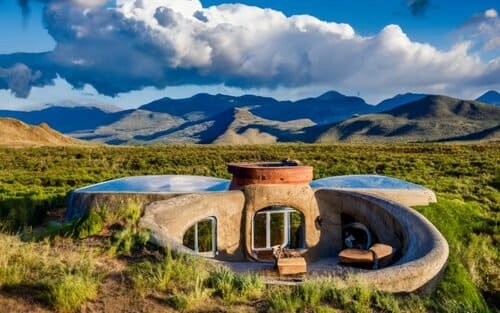Greetings! Today, I want to introduce you to an innovative and sustainable housing solution: tire homes. These unique dwellings, also known as Earthships, offer a perfect blend of eco-friendliness, creativity, and off-grid living. By utilizing discarded materials and green building techniques, tire homes are transforming the way we think about sustainable architecture and environmentally friendly homes.
Imagine living in a home constructed with stacked tires, cans, and bottles, all embedded in cement. These repurposed materials create the walls of a tire home, making use of what would otherwise be waste. But tire homes go beyond just recycling. They are designed to be completely self-sufficient, utilizing renewable energy sources and practicing sustainable living principles.
- Tire homes, also known as Earthships, are sustainable and eco-friendly homes built using discarded materials like tires, cans, and bottles.
- They are designed to be completely self-sufficient, utilizing natural and repurposed materials, renewable energy sources, and sustainable living principles.
- Tire homes offer numerous benefits, including reduced dependence on external utilities, lower carbon footprint, and durability against extreme weather events.
- Building a tire home involves careful planning and adherence to sustainable building practices, minimizing environmental impact.
- As awareness of sustainable living grows, tire homes may become a more mainstream housing option in the future.
The Principles of Tire Homes
Tire homes, also known as Earthships, are built on the principles of sustainability and environmental consciousness. These homes prioritize the use of natural and repurposed materials, reducing the demand for new resources and minimizing waste. By embracing green building materials and techniques, tire homes offer a unique approach to sustainable housing.
Let’s explore the key principles that define tire homes:
- Use of Natural and Repurposed Materials: Tire homes are constructed using discarded materials such as tires, cans, and bottles. These materials are stacked and embedded in cement to create the walls of the home. This sustainable approach reduces the use of new resources and repurposes materials that would otherwise end up in landfills.
- Thermal or Solar Heating and Cooling: Tire homes use thermal and solar heating and cooling systems to regulate the temperature inside the home. By harnessing the power of the sun and utilizing natural ventilation techniques, these homes can maintain a comfortable living environment with minimal energy consumption.
- Generation of Electricity: Tire homes embrace renewable energy sources such as solar and wind. By installing solar panels and wind turbines, these homes can generate their own electricity, reducing dependence on the traditional power grid.
- Rainwater Harvesting and Reuse: Another important principle of tire homes is the collection and reuse of rainwater. These homes have systems in place to capture rainwater and store it for various purposes such as irrigation, flushing toilets, and washing clothes. This reduces the reliance on freshwater sources and promotes sustainable water management.
- Contained Sewage Treatment: Tire homes are equipped with their own contained sewage treatment systems. These systems ensure that wastewater is properly treated and reused, minimizing the environmental impact and reducing the strain on public sewage systems.
- On-Site Food Production: One of the unique features of tire homes is the ability to grow or produce food on-site. These homes often include greenhouses or gardens where residents can cultivate their own fruits, vegetables, and herbs. This promotes self-sufficiency and reduces the need for transporting food from external sources.
By adhering to these principles, tire homes embody sustainable architecture and off-grid living, providing a eco-friendly and self-sufficient housing solution.
The Benefits of Living in a Tire Home
Living in a tire home offers numerous benefits. These homes are self-contained and run off the power grid, reducing dependence on external utilities. They are constructed with at least 40% recycled materials, making them environmentally friendly. Tire homes also have a lower carbon footprint compared to traditional homes, as they utilize renewable energy sources and reduce waste.
Tire homes provide a sustainable housing solution that promotes off-grid living and environmentally friendly homes. By reducing reliance on external utilities, tire homes contribute to a more self-sufficient lifestyle while minimizing the impact on the environment.
One key advantage of living in a tire home is their construction using recycled materials. With a minimum of 40% recycled materials, tire homes contribute to the reduction of waste and promote sustainable practices in the construction industry. By repurposing materials like tires, these homes help divert waste from landfills while creating a unique and visually striking architectural design.
In addition to their eco-friendly construction, tire homes incorporate renewable energy sources. Solar panels and wind turbines are commonly used to generate electricity and power these homes, reducing reliance on fossil fuel-based energy. This not only helps reduce carbon emissions but also provides homeowners with long-term energy cost savings.
Tire homes are also designed to be resilient and can withstand extreme weather events such as hurricanes and tornadoes. The thick, densely packed walls made of stacked tires provide excellent thermal insulation and structural strength. This makes tire homes more durable and capable of withstanding natural disasters, enhancing the safety and security of residents.
Benefits of Living in a Tire Home:
- Reduced dependence on external utilities
- Environmentally friendly construction using recycled materials
- Lower carbon footprint and energy cost savings
- Resilient and capable of withstanding extreme weather events
Living in a tire home is not just about sustainability, but also about embracing a more conscious and mindful lifestyle. These homes encourage individuals to reconnect with nature, adopt a more minimalist approach, and cultivate a sense of self-sufficiency. By choosing to live in a tire home, individuals can make a positive impact on the environment while enjoying the numerous benefits of sustainable, off-grid living.
Building a Tire Home
 Building a tire home is an innovative approach to sustainable housing, utilizing green building materials and a construction method known as earthbag construction. This method involves stacking tires like bricks and embedding them in cement to create sturdy walls for the home.
Building a tire home is an innovative approach to sustainable housing, utilizing green building materials and a construction method known as earthbag construction. This method involves stacking tires like bricks and embedding them in cement to create sturdy walls for the home.
The use of tires not only repurposes discarded materials, but it also provides excellent thermal insulation. By filling the tires with compacted soil, they act as thermal batteries, retaining heat from sunlight and regulating the temperature inside the home. This natural insulation helps to reduce energy consumption for heating and cooling.
In addition to tires, other recycled materials such as cans and bottles can be incorporated into the design of a tire home. These materials can create unique design elements and provide natural lighting through stained glass-like walls. This approach adds a touch of creativity and environmental consciousness to the construction process.
Benefits of Earthbag Construction:
- Utilizes recycled materials
- Excellent thermal insulation
- Reduces energy consumption
- Creative design opportunities
“Building a tire home not only supports sustainable housing but also promotes a circular economy by repurposing discarded materials.”
When building a tire home, it is crucial to adhere to sustainable building practices and choose materials that minimize environmental impact. The construction process requires careful planning and attention to detail to ensure a durable and efficient home.
| Pros | Cons |
|---|---|
| Environmentally friendly | Requires specific construction expertise |
| Energy-efficient | Time-consuming construction process |
| Cost-effective in the long run | May not be suitable for all climates |
The Future of Tire Homes
 The concept of tire homes, pioneered by architect Michael Reynolds, has gained popularity in recent years. The demand for sustainable and eco-friendly housing options has increased, leading to the construction of tire homes in various locations across the United States and internationally. Tire homes offer a unique blend of creativity and sustainability, allowing individuals to live off-grid and reduce their environmental impact.
The concept of tire homes, pioneered by architect Michael Reynolds, has gained popularity in recent years. The demand for sustainable and eco-friendly housing options has increased, leading to the construction of tire homes in various locations across the United States and internationally. Tire homes offer a unique blend of creativity and sustainability, allowing individuals to live off-grid and reduce their environmental impact.
As awareness of the importance of sustainable living continues to grow, tire homes may become a more mainstream housing option in the future.
Inspired by tire homes, architects and builders are exploring innovative ways to create eco-friendly homes, using green building materials and sustainable design principles. These homes aim to minimize the impact on the environment while providing comfortable and modern living spaces.
Advancements in Sustainable Housing
The future of tire homes lies in the advancements of sustainable housing technologies and practices. Architects and designers are constantly researching and implementing new green building materials and techniques to enhance energy efficiency, reduce waste, and ensure long-term sustainability.
- Alternative building materials such as bamboo, reclaimed wood, and recycled materials are being used to create eco-friendly structures.
- Solar panels, wind turbines, and geothermal systems are becoming more affordable and accessible, allowing homeowners to generate clean and renewable energy.
- Smart home technology is being integrated into sustainable housing designs, enabling homeowners to monitor and optimize energy usage.
- Water conservation systems and greywater recycling technologies are being incorporated to reduce water consumption.
These advancements in sustainable housing will not only contribute to a greener future but also offer homeowners the opportunity to create healthy and energy-efficient living spaces.
“The future of housing lies in sustainable and eco-friendly practices. Tire homes have paved the way for innovative and creative solutions that prioritize the environment and our well-being.” – Michael Reynolds
With increasing awareness and demand for sustainable alternatives, tire homes and other eco-friendly housing options are likely to become widely accepted and embraced by communities. The future holds the promise of a more environmentally conscious society where sustainable living is the standard.
Real-Life Examples of Tire Homes
 When it comes to sustainable housing, tire homes, also known as Earthships, have gained popularity as unique and eco-friendly housing options. These innovative homes showcase the use of green building materials and demonstrate the potential of sustainable architecture. Let’s explore some real-life examples of tire homes around the world.
When it comes to sustainable housing, tire homes, also known as Earthships, have gained popularity as unique and eco-friendly housing options. These innovative homes showcase the use of green building materials and demonstrate the potential of sustainable architecture. Let’s explore some real-life examples of tire homes around the world.
Taos, New Mexico
One notable location where tire homes have made a significant impact is Taos, New Mexico. In this picturesque town, architect Michael Reynolds built the first Earthship community. These homes are specifically designed to withstand the desert climate and utilize sustainable features to minimize their environmental impact.
By incorporating rainwater harvesting systems, solar and wind energy sources, and on-site food production capabilities, these Earthships promote self-sufficiency and sustainable living. They effectively demonstrate how tire homes can thrive in challenging environments while embracing environmentally friendly practices.
Michigan’s Off-the-Grid Earthship
Another inspiring example of tire home construction can be found in Michigan, where a family is building their own off-the-grid Earthship home. With a strong focus on sustainability, they are using recycled materials such as tires and bottles to create their unique haven.
This Earthship embodies the principles of sustainable housing, showcasing the potential for self-sufficiency and eco-friendliness. As the construction progresses, this family is making a positive impact by reducing their carbon footprint and inspiring others to consider alternative housing options.
These real-life examples demonstrate the versatility and potential of tire homes as sustainable and eco-friendly housing alternatives. By combining green building materials, off-grid features, and innovative design, tire homes offer a path towards a more sustainable future.
Conclusion
Tire homes, also known as Earthships, are a revolutionary solution for sustainable housing. These unique homes prioritize the use of recycled and repurposed materials, such as tires, cans, and bottles, which reduces waste and minimizes the need for new resources. By harnessing renewable energy sources, employing off-grid living techniques, and implementing green building materials, tire homes offer an eco-friendly alternative for those seeking a more sustainable lifestyle.
With their self-sufficient design, tire homes are able to operate independently from external utilities, reducing reliance on traditional power grids and water sources. This self-sustainability not only promotes a greener future but also allows homeowners to have greater control over their energy consumption and environmental impact. Additionally, tire homes have a significantly lower carbon footprint compared to conventional houses, thanks to their utilization of renewable energy and efficient insulation systems.
As awareness of environmental issues continues to grow, there is an increasing demand for eco-friendly homes. Tire homes provide a practical and accessible option for individuals who wish to live in a sustainable and energy-efficient manner. With their unique design and innovative features, tire homes demonstrate the potential for environmentally conscious living, proving that it is possible to combine modern comfort with sustainable practices. As we look to the future, tire homes may become a staple in the sustainable housing industry, offering a viable solution for a greener and more eco-friendly way of life.
FAQ
What are tire homes?
Tire homes, also known as Earthships, are sustainable and eco-friendly homes that are built using discarded materials such as tires, cans, and bottles. These materials are stacked and embedded in cement to create the walls of the home.
What are the key principles of tire homes?
The key principles of tire homes are: 1) Using natural and repurposed materials, 2) Utilizing thermal or solar heating and cooling, 3) Generating electricity from solar and wind energy, 4) Harvesting and reusing rainwater, 5) Having a contained sewage treatment system, and 6) Enabling on-site food production.
What are the benefits of living in a tire home?
Living in a tire home offers benefits such as being self-contained and off the power grid, reduced carbon footprint, resilience to extreme weather events, and a step towards a sustainable and environmentally conscious lifestyle.
How do you build a tire home?
Building a tire home involves stacking tires like bricks and embedding them in cement to create the walls. The tires are filled with compacted soil to act as thermal batteries. Other materials like cans and bottles can also be used for unique design elements and natural lighting.
What is the future of tire homes?
With the increasing demand for sustainable and eco-friendly housing options, tire homes may become a more mainstream choice in the future for those seeking a greener lifestyle.
Are there any real-life examples of tire homes?
Yes, there are real-life examples of tire homes, such as the Earthship community in Taos, New Mexico, and a family in Michigan building their own off-the-grid Earthship home using recycled materials.
Why should I choose a tire home?
Tire homes offer a unique and sustainable approach to housing, prioritizing recycled materials, renewable energy sources, and reduced reliance on external utilities. They are a step towards a greener future and a more sustainable lifestyle.













